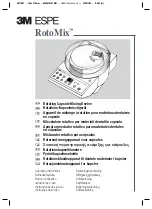
K. BRACKETS AND CANTILEVERED PLATFORMS
1.
Brackets for SYSTEM SCAFFOLDS shall be installed and used in accordance with manufacturer’s recommendations.
2.
Brackets for FRAME SCAFFOLDS shall be seated correctly with side bracket parallel to the frames and end brackets at 90 degrees to the frames.
Brackets shall not be bent or twisted from normal position. Brackets (except mobile brackets designed to carry materials) are to be used as work
platforms only and shall not be used for storage of material or equipment.
3.
Cantilevered platforms shall be designed, installed and used in accordance with manufacturer’s recommendations.
L. ALL SCAFFOLDING COMPONENTS
shall be installed and used in accordance with the manufacturer’s recommended procedure. Components shall
not be altered in the field. Scaffold frames and their components manufactured by different companies shall not be intermixed, unless the component
parts readily fit together and the resulting scaffold’s structural integrity is maintained by the user.
M. PLANKING
1.
Working platforms shall cover scaffold bearer as completely as possible. Only scaffold grade wood planking, or fabricated planking and decking meeting
scaffold use requirements shall be used
2.
Check each plank prior to use to be sure plank is not warped, damaged, or otherwise unsafe.
3.
Planking shall have at least 12" overlap and extend 6" beyond center of support, or be cleated or restrained at both ends to prevent sliding off supports.
4.
Solid sawn lumber, LVL (laminated veneer lumber) or fabricated scaffold planks and platforms (unless cleated or restrained) shall extend over their end
supports not less then 6" nor more than 18". This overhang should not be used as a work platform.
N. FOR "PUTLOGS" AND "TRUSSES" THE FOLLOWING ADDITIONAL GUIDELINES APPLY:
1.
Do not cantilever or extend putlogs/trusses as side brackets without thorough consideration for loads to be applied.
2.
Putlogs/trusses should be extended at least 6" beyond point of support.
3.
Place recommended bracing between putlogs/trusses when the span of putlog/truss is more than 12 feet.
O. FOR ROLLING SCAFFOLDS THE FOLLOWING ADDITIONAL GUIDELINES APPLY:
1.
RIDING A ROLLING SCAFFOLD IS VERY HAZARDOUS. The Scaffold Industry Association does not recommend nor encourage this practice.
However, if you choose to do so, be sure to follow all state, federal or other governmental guidelines.
2.
Casters with plain stems shall be attached to the panel or adjustments screw by pins or other suitable means.
3.
No more than 12 inches of the screw jack shall extend between the bottom of the adjusting nut and the top of the caster.
4.
Wheels or casters shall be provided with a locking means to prevent caster rotation and scaffold movement and kept locked.
5.
Joints shall be restrained from separation.
6.
Use horizontal diagonal bracing near the bottom and at 20 foot intervals measured from the rolling surface.
7.
Do not use brackets or other platform extensions without compensating for the overturning effect.
8.
The platform height of a Rolling Scaffold must not exceed four (4) times the smallest base dimension (CAL/OSHA and some Government agencies
require a stricter ratio of 3 to 1).
9.
Cleat or secure all plank.
10. Secure or remove all materials and equipment from platform before moving.
11. Do not attempt to move a rolling scaffold without sufficient help – watch out for holes in floor and overhead obstructions – stabilize against tipping.
P. SAFE USE OF SCAFFOLD
1.
Prior to use, inspect scaffold to insure it has not been altered and is in safe working condition.
2.
Erected scaffolds and platforms should be inspected continuously by those using them.
3.
Exercise caution when entering or leaving a work platform.
4.
Do not overload scaffold. Follow manufacturer’s safe working load recommendations.
5.
Do not jump onto planks or platforms.
6.
Do not use ladders or makeshift devices on top of working platforms to increase height or provide access from above.
7.
Climb in access areas only and USE BOTH HANDS
I.
WHEN DISMANTLING SCAFFOLDING THE FOLLOWING ADDITIONAL GUIDELINES APPLY:
A. Check to assure scaffolding has not been structurally altered in a way which would make it unsafe and, if it has, reconstruct where necessary before
commencing with dismantling procedures. This includes all scaffold ties.
B. Visually inspect plank prior to dismantling to be sure they are safe.
C. Consideration must be given as to the effect removal of a component will have on the rest of the scaffold prior to that component’s removal.
D. Do not accumulate excess components or equipment on the level being dismantled.
E. Do not remove ties until scaffold above has been removed (dismantled).
F. Lower dismantled components in an orderly manner. Do not throw off of scaffold.
G. Dismantled equipment should be stockpiled in an orderly manner.
H. FOLLOW ERECTION PROCEDURES AND USE MANUALS.
These safety guidelines (Code of Safe Practice) set forth common sense procedures for safely erecting, dismantling and using scaffolding equipment.
However, equipment and scaffolding systems differ, and accordingly, reference must always be made to the instructions and procedures of the supplier
and/or manufacturer of the equipment.
202009






























